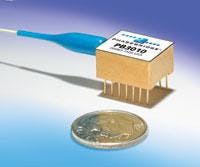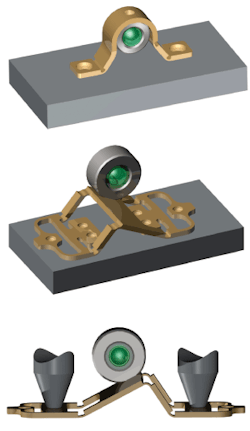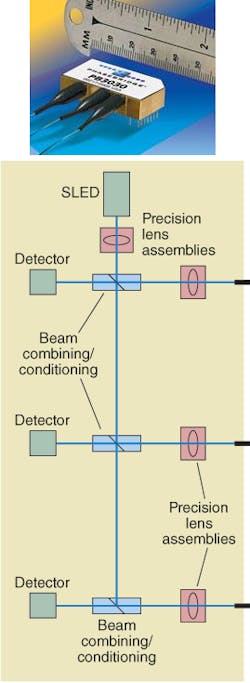Optical integration improves fiberoptic gyroscopes
K.K. WONG and RONALD T. LOGAN JR.
As real-time position and trajectory guidance mature, the fiberoptic gyroscope (FOG) is becoming an important centerpiece of navigation systems. Increases in optical integration and decreases in component and manufacturing costs are driving adoption of FOGs as the guidance technology of choice in the most demanding applications.
Fiberoptic gyroscopes are playing an increasing role in both civilian and military guidance systems as recent advances in gyroscope-component manufacturing technologies have accelerated their adoption. The closest alternative technology, the ring-laser gyroscope, is still widely deployed in many aerospace applications. However, they suffer from reliability concerns related to their gas lasers and high drive voltages. Other mature guidance technologies include global-positioning systems (GPS), spinning-mass gyroscopes, hemispherical resonator gyroscopes, and microelectromechanical systems (MEMS)-based gyroscopes, but most of these technologies are typically used in lower-precision situations and have significant limitations in precise, rapid, and rugged applications. Furthermore, GPS suffers from denied signal access in hostile or obstructed environments. Fiberoptic gyroscopes (FOGs) have no moving parts, feature “instant on” capability with no significant warm-up period, and have a variable sensitivity depending on the length of the fiber-sensing spool, so they perform well in many applications.
Unfortunately, the size and cost of the FOG components, principally transceiver elements and polarization-maintaining (PM) fiber, have until now limited their use to mostly high-performance situations. However, the recent availability of low-cost PM fiber, high-power low-coherence light sources, and rugged hybrid photonic packaging techniques have ushered in a new generation of FOG components that are breaking the price, size, and performance barriers for FOGs. The proliferation of FOG applications includes commercial and military aircraft, guided munitions, terrestrial vehicles, submarine environments, industrial and military robotics and unmanned vehicles, and real-time stabilization.
FOG operation
A FOG exploits the Sagnac effect, which is the difference in time-of-flight for counter-propagating light in a circular optical path caused by the rotational velocity of this loop. Light propagating clockwise through a fiber loop will have the same optical path length as light that propagates counter-clockwise if the loop is at rest. However, if the loop is rotated while the light is propagating through the fiber, the beginning and ending points of the loop are shifted during the optical propagation, with the result that one beam will have farther to travel than the other, depending on which direction the loop is rotated. The path difference can be measured as a phase difference by interfering the beams from the two directions. Thus, a fiber loop can be used as a rotation sensor.
To increase the precision of a FOG loop, the optical fiber is wound many times to form a coil. In high-accuracy applications, several kilometers of fiber can be used in each coil. For each of the three spatial axes, a FOG uses a transmitter to generate a beam of light into a fiber. This light is then split into two serrodyne-modulated beams using a phase modulator, and these beams are fed into opposite ends of the fiber loop. In order to interfere the light emerging from the loop, PM fiber is used, and the returning light passes through the phase modulators and is then recombined and detected. The phase modulators serve to move the interfered signal away from the noise spectrum around a DC zero-frequency point, enhancing the sensitivity of the FOG. By detecting the interference fringes, the FOG measures rotation in that axis, and by combining all three axes, complete information on orientation is obtained. Interferometric FOGs (IFOGs) typically use a low-coherence optical source, such as a superluminescent light-emitting diode (SLED) or an erbium-based amplified spontaneous emission (ASE) source, so that noise induced from multiple reflections, Rayleigh backscattering, and nonlinear effects are reduced.
A complete IFOG therefore consists of at least three low-coherence transmitters, three splitters, six phase modulators, three receivers, and three PM fiber spools. A modern IFOG combines the transmitter and receiver functions into one integrated transceiver package for each axis. Similarly, the splitter and phase modulator pairs are combined into one modulator package for each axis (see Fig. 1). Current development efforts are focused on reducing the size and cost of this assembly, while maximizing sensitivity and immunity to shock, vibration, and temperature extremes.
Transceiver miniaturization
Just as precision fiber positioning enabled the packaging of individual photonic devices, the recent emergence of precision lens mountingis now enabling the integration of multiple photonic devices into a single package. Recent advances in transceiver integration have led to commercially available FOG transceivers with dimensions as small as 0.6 × 0.5 × 0.3 in. (15 × 13 × 8 mm; see Fig. 2).To develop such a compact transceiver without sacrificing performance, new lens mounting technology was developed that allows submicron lens positioning in the context of an optical package. A flat-footed positioning bracket translates coarse operator manipulation into precise positioning of the lens (see Fig. 3, top). The feet of this bracket are adjusted laterally, and once the correct lens position has been achieved, low-shift electrical welds are made using the manipulating tool as a resistance welder, with the resulting friction helping to control weld shift. Using these so-called "simple brackets," the combination of two submicron lap welds results in a precision of roughly 1 μm.
A more precise “compound bracket” (see Fig. 3, center) augments the simple bracket by providing enhanced precision using spring attenuation. Compound brackets are used in applications requiring extreme precision or post-attachment fine positioning to improve yields. The bracket is first manipulated at the inner feet and welded into position in a procedure similar to the simple bracket (see Fig. 3, bottom). Next, the tools engage the outer feet and reestablish optimum lens position to correct for previous weld shifts at the inner feet. When position has been reestablished, the outer feet are welded into place, and the final weld shifts are attenuated by the stiff-spring attenuation provided by the feet of the compound bracket. The compound bracket achieves a positioning accuracy of less than 0.3 μm.Thus, the simple brackets offer micron-level positioning and the extremely small bracket size necessary to fit into some of the smaller package standards, such as miniature dual-inline (mini-DIL) packages, or extremely low-profile military applications. The compound brackets achieve greatly enhanced performance by using a two-step weld process with stiff-spring/soft-spring attenuation to reduce the effect of the final weld shift. Initial positioning and bonding is executed by positioning and then welding the inner “coarse weld” feet; the outer “fine adjust” tabs are then adjusted, using the same manipulators, to reposition the lens or fiber by eliminating radial offset due to shifts taking place while attaching the inner feet. Throughout the second-stage process of fine adjustment and final welding, the spring attenuators perform the dual function of enhancing precision and then “absorbing” weld shift using the concept of series stiff-spring/soft-spring attenuation. Compound brackets typically reduce weld shift by a factor of five for typical 7-mm-wide brackets, with higher levels of attenuation possible in larger brackets. In applications that do not require tenth-micron-level precision, compound brackets allow for easy reworkability, since the outer feet can be used to correct for any process-related shifts that occur during product assembly or testing.
For a FOG to survive demanding environments such as those in guided weapons or military vehicles, the components must meet extremely harsh shock and vibration specifications. In addition, operating and storage temperatures vary widely (typically -54°C to +85°C), and of course reliability and long shelf life are of paramount importance. While the exact specifications are often proprietary or classified, it is clear that traditional telecom-grade production techniques are not appropriate for these environments. The lens mounting and positioning techniques described here have been specifically developed to meet these demanding criteria and are currently being used to produce IFOG transceiver packages with a high degree of hybrid integration. The use of free-space optics permits the widest possible range of devices from multiple materials systems to be employed, including SLEDs, detectors, and other passive optical conditioning elements, and this is not possible today with monolithic waveguide integration techniques.
Further integration and cost reduction
In the future, FOGs will continue to evolve as their components become increasingly integrated. Because FOGs use three of each type of component to measure each of the three axes of rotation, combining three transceivers or three modulators into one package is the next evolutionary step. A three-axis transceiver prototype, in which all three transmitters and receivers are copackaged along with the necessary passive optics, has been fabricated by Phasebridge under funding from the Center for Commercialization of Advanced Technologies (CCAT; see Fig. 4). Using a single SLED and a single optical package to serve all three axes results in a large cost savings for the entire FOG assembly. When thte next generation of this three-axis transceiver is fully commercialized, it will share a single SLED across all three axes, and the result will be a substantial decrease in cost and assembly complexity for the overall FOG.Integration enhancements in the modulator package will complement this transceiver integration. Coupled with decreases in the price of PM fiber and continuous component improvements, these technologies are causing FOGs to experience large market growth. Hybrid optical integration not only enables higher performance and enhanced environmental survivability for the overall FOG, but also results in significantly lower assembly costs.
K.K. Wong is director of engineering projects and Ronald T. Logan Jr. is the founder and chief technical officer of Phasebridge, 859 Raymond Ave., Pasadena, CA 91105; e-mail: [email protected].
Miniaturization and performance drive innovation
Whether manufacturing a system module, an array of similar devices, or even a single source or detector, miniaturization to reduce component weight, footprint, and overall assembly cost is often the driver for innovation in optoelectronics manufacturing.
At the system level, K.K. Wong and Ronald T. Logan Jr. of Phasebridge show how a compact, three-axis transceiver can improve the performance of a fiberoptic gyroscope. John Marsh and Steve Najda of Intense integrate individually addressable single-mode laser-array modules to create “super arrays.” And, in the case of chip-level devices in which further miniaturization is difficult, Al Benzoni and colleagues at Xponent Photonics are etching rather than cleaving laser facets to build better edge-emitting devices.—Gail Overton



